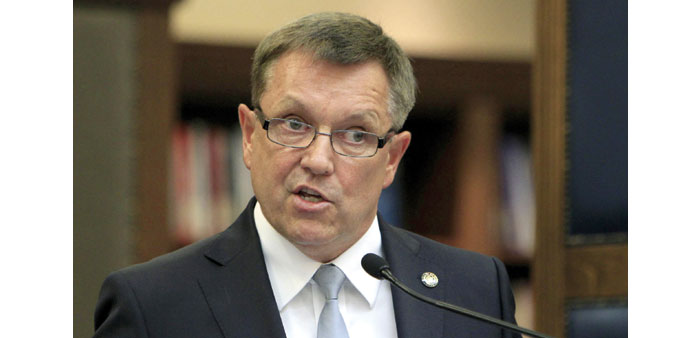Reuters/Budapest
Hungary’s central bank said yesterday’s 20 basis point cut in its benchmark interest rate was the last in a 2-year campaign to help the economy and it planned to keep the rate at 2.1% until the end of next year.
The bank has reduced borrowing costs from a 7% peak in 2012 to record lows, helped by the flood of capital from the US Federal Reserve which many investors have diverted into riskier emerging markets including Hungary’s.
Government-imposed energy price cuts have held down Hungarian inflation, smoothing the way for the central bank, run by a close ally of Prime Minister Viktor Orban, to support the government’s efforts to bolster economic growth.
“Unless there is a negative shift in inflation trends, then the central bank will keep the base rate at 2.1% until the end of 2015,” Governor Gyorgy Matolcsy told a news conference.
“Of course we are looking at market developments thoroughly, prudently, conservatively and responsibly, but we have only one anchor, namely the medium-term inflation target.”
Last week’s Reuters poll had predicted the base rate would reach a floor at 2.1%.
Matolcsy said that “in theory” the Monetary Council does not rule out starting a new rate cut cycle sometime in the future if inflation trends justify this.
“But today this does not seem either realistic or necessary,” Matolcsy said, adding that beyond 2015, neither a rate increase, nor a new cutting cycle could be ruled out.
Low inflation and sustained monetary easing by the European Central Bank have kept the region’s policymakers focussed on supporting economic recovery.
However, only the National Bank of Hungary has kept cutting rates steadily in 2014 despite wobbles in emerging markets and a crisis in neighbouring Ukraine.
The forint has eased gradually, by about 10% since the start of the steady stream of rate cuts in 2012, while government bond yields have dropped to record lows.
Yesterday the forint jumped to a 4-week high of 307.55 per euro after the bank said the rate cut cycle was over. Government bonds gave up early gains, but with yields rising 4-5 basis points they were almost unchanged from Monday.
Yesterday’s last cut was double the 10 basis points forecast by all 18 analysts in a July 15-17 Reuters poll.
Most analysts had expected the bank to stop cutting before the government goes ahead with a conversion of some $15bn worth of foreign currency mortgages into forints at the end of this year.
That could add substantially to the costs of mostly foreign-owned banks who already face substantial losses from other government moves to help Hungarian borrowers this year.
These measures increase the risks for foreign investors who finance a large chunk of Hungary’s debt, at a time when the turn in Fed policy could suck capital from emerging markets.
As inflation is also expected to climb back towards the Hungarian bank’s medium-term target by the end of next year, most analysts expect it to start reversing its rate cuts in 2015.
UBS analyst Gyorgy Kovacs said before yesterday’s rate decision that the bank would likely raise its base rate to 3.5% by the end of next year.
In last week’s Reuters poll, analysts’ median forecast was for 2.8%.
“A key risk to our rate call is that earlier rate hikes might be necessary if the normalisation of US monetary policy and a stronger dollar start to put pressure on the forint, given the still very high share of local currency debt owned by non-resident investors,” UBS’s Kovacs said in a note.

